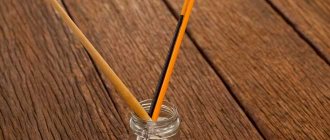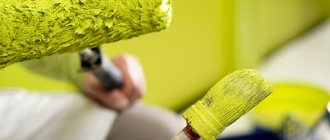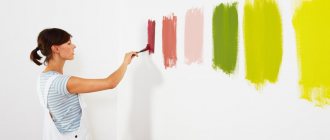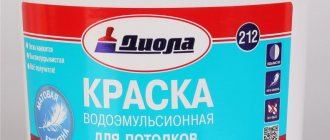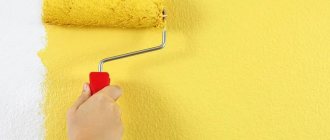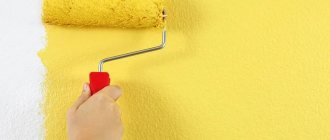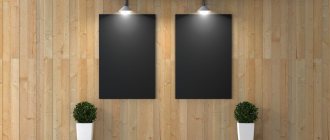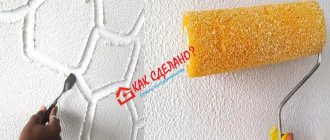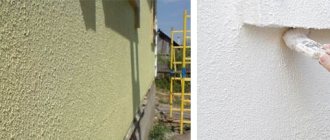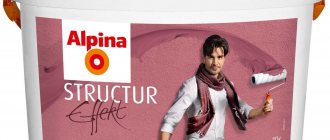Painting the ceiling is an important stage when carrying out finishing work in a residential or public space. To achieve optimal results and long-term operation of the finished surface, it is necessary to choose the most suitable paint and varnish composition for interior work. Ceiling paint must meet the conditions of environmental safety, practicality, reliability, durability and other important criteria. One of the most popular types of finishing materials for ceilings is acrylic paint, which has a low price and excellent performance properties.
Ceiling painted with acrylic paint
Feature of acrylic
Paints of this type are produced chemically by adding methacrylic acid, which has the following features:
- The synthesis of the material makes it possible to obtain a homogeneous polymer composition that is not subject to biological decomposition and retains its performance properties in an aquatic environment.
- Synthesized acrylic granules dissolve well when carrying out chemical reactions with some other substances.
- Acrylic firmly holds the pigment and is painted over the entire volume.
- Dissolved acrylic quickly polymerizes, forming a high-strength film that is resistant to mechanical stress and negative environmental influences.
Acrylic granules
These properties, discovered by chemists during the repeated synthesis of acrylic acids, made it possible to obtain a high-quality paint and varnish composition, the scope of application and performance qualities of which are improving every year.
Environmental friendliness
Considering the pros and cons of acrylic kitchens, it is safe to say that acrylic is preferable to plastic in many cases. And not even because such products have an original design, are strong, durable and wear-resistant.
The most important difference from plastic is the absence of toxic fumes that pose a threat to the health of households. Acrylic does not contain carcinogenic substances and various resins; its environmental friendliness is beyond doubt.
Advantages of acrylic paints
Modern acrylic decorative and protective materials, widely used in interior finishing work, have many advantages when comparing them with similar compositions:
- Quick drying of the applied composition, subject to the recommended layer thickness.
- Due to the presence of a dense polymer film, the coating has increased wear resistance. With minor mechanical impact, scratches do not form on the surface.
- The elastic polymer included in the composition allows you to smooth out small defects and cracks in the preparation of the ceiling when applying and polymerizing a viscous substance.
Elastic coating after drying
- Increased resistance to prolonged exposure to ultraviolet radiation.
- Fire safety of all components included in the paint.
- Increased moisture resistance and preservation of functional features during sudden temperature changes, which significantly expands the scope of application of the material.
- Possibility of wet surface cleaning.
- When applied, the composition does not emit a specific odor, does not emit toxins, and does not cause irritation to the human respiratory tract.
- Most compositions spread evenly on the prepared surface and are characterized by increased efficiency - the average consumption, when applied in 1 layer, is no more than 130 - 200 g/m2.
Eco-friendly acrylic paint
Acrylic paint, depending on the concentration of pigments, is available in different shades and can be easily tinted directly at the point of sale. The presence of universal binding components allows the substance to be used when applied to any type of surface.
VDAK-111
The paint is suitable for finishing facades and interior surfaces. It demonstrates resistance to moisture and atmosphere, which extends its life up to five years. But the composition cannot be used for painting floors - intense loads lead to its rapid abrasion.
Evgeniy Filimonov
Ask a Question
The surface does not require complex preparation before using paint.
The product is environmentally friendly and has the following characteristics:
- At a temperature of about 20 degrees, the paint hardens within an hour.
- The consumption rate is 100-150 grams per square meter.
- The paint has a white tint that can be tinted.
- The material is resistant to moisture and ultraviolet radiation. When finished, it can easily withstand temperatures from minus 50 to plus 60 degrees.
- Before work, the structure must be primed. If the paint thickens, you can partially dilute it using thinner or plain water.
Disadvantages of acrylic paints
Despite the presence of many advantages, experts and consumers highlight some disadvantages of this finishing material when applied to the ceiling:
- Like any other interior paint, the composition is applied to a smooth surface of a large area in a thin layer. In this regard, any unevenness or sagging in the rough finish inevitably affects the quality of the finishing coating, which requires increased attention when preparing the ceiling.
- Acrylic paint is a popular product and most manufacturers compete to achieve the cheapest retail price. This often leads to a decrease in the quality of the material and a deterioration in its performance characteristics.
- Acrylic-based paint is capricious in the choice of tool for its application. When using rollers or brushes with insufficiently soft bristles, bristles or fur, stripes appear on the surface, which spoil the appearance of the finish.
Painting tool
It should also be mentioned that from batch to batch, the shade of paint may change, since the manufacturer or technologist in the store is not able to control the pigment dosage with an accuracy of milligrams. When buying paint, you need to accurately calculate the volume and tint the entire amount of material at once with a single dosage, so that after application the surface is the same shade.
VDAK-1180
Water-dispersed acrylic paint meeting GOST 1180 is used as a starting and secondary coating. Designed mainly for external facades. Suitable for finishing large industrial facilities. The paint is offered in various colors. It is resistant to moisture, low and high temperatures. But the compositions are quite thick, so they are not suitable for interior work.
Characteristics of VDAK-1180 paint:
- The color of the coating can be any. It turns out smooth and matte.
- The paint is moisture resistant and remains breathable.
- It takes an hour to dry the surface.
- The dye has a mild aroma.
- The average composition consumption is 65 grams per square meter. The permissible solvent level is up to 5%.
This type of coating is packaged in one and a half kilogram containers. If you add a lot of water during the dilution process, the dye will have a grayish tone. You can apply paint to the surface with a regular brush or roller.
Tools needed to apply acrylic composition
To achieve an impeccable result, you need to stock up on a set of high-quality painting tools, which includes the following items:
- Roller with soft faux fur. The tool should absorb the paint well and hold it inside without splashing.
- A set of brushes with soft bristles for finishing corners and joining ceilings with walls in hard-to-reach places.
- A tray with a grooved surface for rolling out the roller and removing excess paint from it.
Roller with tray
If several rooms in an apartment or house are to be painted, and the total ceiling area exceeds 100 - 150 m2, an advisable solution would be to use a spray gun, which will ensure uniform application of a layer of acrylic paint in a short time.
Gloss or matte finish?
A glossy surface or a matte effect is, of course, a matter of taste and a matter of compliance with the project of the future interior, but both options have their advantages and disadvantages.
For example, a glossy ceiling will look presentable if its surface is leveled to perfect condition before painting; otherwise, the coating will highlight every flaw, even the slightest roughness.
Walls in the kitchen or bathroom, painted with glossy paint, will hide water splashes and drips and will be better amenable to wet cleaning.
A matte finish does a good job of masking imperfections in the surface being painted and visually expanding the space in the room, but dirt on it is much more clearly visible and is a little more difficult to clean.
The gloss glares, reflecting light, and matte walls and ceilings look very restrained.
Types of acrylic paints
Depending on the composition, functional features, hardening time and wear resistance, acrylic ceiling paints are divided into 4 main types, each of which is described in detail below.
Water-dispersed
This type of paint contains special film-forming substances that are formed during polymerization, creating a reliable protective barrier. Advantages of this type of paint:
- Increased hydrophobization with unchanged vapor permeability makes it possible to apply the coating in bathrooms or kitchens. Condensation does not collect on the surface, which prevents the growth of bacteria and the formation of fungus.
- The synthetic components included in the substance do not cause allergic reactions.
- When heated, the paint does not release toxins or odors, maintaining its performance properties.
- Belongs to the class of fireproof non-combustible substances.
- It is characterized by increased durability - when choosing a paint coating of this type from a well-known manufacturer, the surface can operate for 10 years or more.
Water-dispersion "Bolars"
In addition to the advantages, this paint and varnish composition has several subjective disadvantages:
- Poor frost resistance, which limits its use in open spaces - balconies and terraces.
- When applied, the composition deteriorates from any concentration of humidity and loses its properties.
- During polymerization, it is necessary to avoid strong drafts, as stains will appear on the surface.
These disadvantages are conditional, and water-dispersion paint is widely used when finishing ceilings in any room
Vinyl acrylic
This type of paint is used exclusively for interior work and, like the previous composition, belongs to water-soluble coatings. Has the same advantages as water-dispersed materials.
The disadvantages include insufficient resistance to any type of acidic or alkaline compounds, which is why the finished ceiling surface is difficult to wet clean. In addition, after application, the composition decreases in volume due to strong shrinkage, which can contribute to the formation of cracks that open during operation.
Vinyl acrylic Dali
Currently, vinyl paints are used less and less, as new, more effective polymer compositions are gradually replacing this obsolete material.
Acrylic silicone
This type of paint coating belongs to materials of a higher price category due to its versatility. Can be used for interior or exterior work, fits perfectly on any type of surface. Some advantages of the composition:
- The silicone additive increases the moisture resistance of the ceiling coating.
- Increased elasticity reduces the risk of cracks due to the integrity of the preparation of the lower part of the floor slab.
- High frost resistance.
- Increased resistance to most chemicals allows wet cleaning with the use of certain cleaning products.
- Easy to apply with a roller or spray gun.
- Applies evenly to concrete, plaster, wood, plasterboard and other surfaces.
- Polymerizes quickly - average drying time is no more than 2 hours.
- Serves for more than 10 - 15 years without the need for new finishing work.
There are few disadvantages to this substance, but they are:
- Increased price compared to other types of acrylic paints.
- Used in combination with a special type of penetrating primer.
- When applied to a dusty surface, the adhesion of the composition is reduced several times.
Acrylic silicone Marshall
Acrylic silicone paint is in high demand among country property owners for decorating ceilings and walls of open spaces, since the original purpose of the material is finishing the facades of buildings.
Styrene acrylic
When synthesizing this composition, a special type of polymer is used, which has the following advantages:
- Increased resistance against negative environmental influences. The composition can be used both indoors and outdoors.
- After polymerization, this type of paint has increased mechanical strength, does not generate dust and does not scratch.
- Does not lose its performance properties when in contact with a damp surface, in direct sunlight and in other aggressive conditions.
Styrene acrylic Belinka
The main disadvantage of this paint is the increased retail cost. However, taking into account the average service life of 12 - 15 years as part of the coating, the slight cost overrun when purchasing is compensated by durability.
VDAK-2180
This finishing material is suitable for interior decoration. It is used for painting ceilings and walls with moderate humidity levels. They can be used to paint wallpaper. The dye gives a high-quality matte finish that is breathable.
Its features stand out:
- Good adhesion to the surface.
- The paint can be used on any surface.
- No roughness or smudges occur during use.
- No unpleasant odor, pleasant white color.
- The material masks unevenness.
- Demonstrates resistance to air.
- The composition hardens in about an hour. It takes a day to dry completely.
- Consumption: about 160-180 grams per square meter.
- The material has hypoallergenic properties.
TOP 5 best manufacturers
The market offers a wide range of acrylic paints from various manufacturers, competing with each other in terms of quality, reliability, wear resistance, ease and uniformity of application, as well as price. Below is a rating of the best manufacturers of acrylic-based ceiling paints that are in active demand among the population in 2022 - 2021.
Tikkurila
One of the world's most famous manufacturers of paint and varnish coatings, founded more than 150 years ago. The company's products are in high demand among professionals and amateurs in more than 100 countries around the world.
Acrylic ceiling paints produced under this brand are distinguished by increased quality, ease of application, durability, resistance to ultraviolet radiation and other qualities. The company represents the following brands of ceiling acrylic paints, which are in active demand among consumers:
- Tikkurila Harmony (average price 850 – 950 rubles per 0.9 l);
- Tikkurila Liitu (1400 – 1600 rubles for 0.9 l);
- Tikkurila Siro Himmea (750 – 850 rubles for 0.9 l);
- Tikkurila Lumi (2400 – 2700 rubles for 2.7 l).
These products are one-component coating compositions that can be applied either manually or mechanically. The average consumption does not exceed 150 ml/m2. The factory composition of such materials is characterized by the absence of color - the paint is tinted at the point of sale, according to the customer’s choice from the presented catalog.
"Lakra"
The largest paint manufacturer in Russia, whose factories are also located in some CIS countries, Poland, Switzerland and Germany on the basis of official partnership agreements. The products are in no way inferior in quality to famous European brands, and in many respects even surpass them. The following set of acrylic paints from this manufacturer is available on the market:
- “Interior acrylic varnish” (350 – 400 rubles for 3 kg);
- “Acrylic varnish for wallpaper” (650 – 750 rubles for 3 kg);
- “Acrylic varnish for ceilings” (200 – 250 rubles per 3 kg).
All Lakra paint is produced in a convenient plastic container-bucket with a handle, which allows it to be sealed tightly after use and has a long shelf life.
VGT
A German brand with full-cycle production in the Russian Federation. The plant has modern European equipment, and all products coming off the assembly lines are subject to careful quality control by representatives of the parent organization. The following brands of acrylic paints suitable for application to the ceiling are widely available:
- VGT VD-AK-1180 (320 – 350 rubles per 1.5 kg);
- VGT VD-AK-2180 (170 – 210 rubles per 1.5 kg);
These paints are tinted at the point of sale. The base includes an elastic polymer that creates a film coating. During long-term use, the surface does not fade in the sun, does not scratch and does not lose its performance properties. Can be used in any premises with high levels of humidity and sudden temperature changes.
"Tex"
Russian brand with a plant in the Leningrad region and a central office in St. Petersburg. The company has existed for more than 20 years and distributes its products not only throughout the Russian Federation, but also abroad. The increased demand is due to the environmental friendliness, reliability and durability of each product. The following types of interior acrylic paints are available on the market:
- “Tex Universal” (220 – 270 rubles per 3 kg);
- “Tex for interiors” (150 – 170 rubles per 0.9 l);
- “Tex Profi” (200 – 250 rubles per 0.9 l).
Acrylic compositions "Tex" go well with the manufacturer's own primer. All paints can be easily washed off after polymerization and can withstand exposure to acidic and alkaline environments.
Dufa
A German brand with a 65-year history, whose products are familiar not only to professional craftsmen, but also to most ordinary people who have encountered the decoration of premises. The quality of the products is evidenced by a customer base of many thousands in more than 100 countries, as well as the presence of official production and sales offices in many countries of Asia and Europe, including the Russian Federation.
The consumer can purchase the following brands of acrylic paints of this brand:
- Dufa Premium KeraLine 3 (350 – 400 rubles for 0.9 l);
- Dufa Premium KeraLine 7 (400 – 450 rubles for 0.9 l);
- Dufa Premium Arctic (450 – 500 rubles per 1.0 l);
- Dufa Premium Velor (4500 - 5500 rubles for 9.0 l).
When releasing products, the company pays increased attention to the environmental safety of each component included in the paint. The coatings from this plant are recommended for use in children's and medical institutions.
This rating is based on real consumer reviews, is subjective in nature and is not a direct indication to purchase the material.
VDAK-449
This paint is used only for painting floors and some other concrete and wood surfaces. It has a pleasant color and no smell. The coating is fireproof, durable and wear-resistant. It is typically used for basements and utility rooms in residential areas where there is no high humidity.
The paint characteristics are as follows:
- The final coating is uniform or semi-matte.
- The color may be red-brown or yellow-brown.
- When properly coated, it can last up to five years.
- Paint consumption is 200-250 grams per square meter.
- It takes about an hour for the coating to dry completely.
- The dye can be diluted with water up to 10%.
In the future, the coating can be easily washed with ordinary water, but this must take at least two weeks from the date of application. For processing you can use a brush or roller. It is not recommended to use paint at temperatures less than five degrees and humidity levels greater than 80%.
Step-by-step instructions for applying acrylic paint for the ceiling
Finishing the ceiling surface using acrylic paint and varnish, if you have a high-quality tool, is a simple job that every home craftsman can do with his own hands. In order for the result to meet expectations and the coating to be used for many years, when applying it, you must follow the step-by-step instructions:
- The finished surface of the ceiling is primed with a penetrating polymer composition combined with a subtype of acrylic paint.
- The upper part of vertical structures that interface with the ceiling surface is covered with masking tape to prevent splashes and the formation of smudges.
- Open a can of acrylic paint, mix the composition thoroughly with a wooden stick or spatula.
Mixing paint in a jar
- 200 - 250 ml of paint is poured into the recesses of the tray, and the roller is immersed there, after which it is rolled along the corrugated plane of the same product to squeeze out excess liquid material.
- The paint is always applied from the corner of the room, the first layer should lie in the same axis where the plane of the window is located.
Applying 1st layer
- The roller is rolled in stripes running along the entire room. The pressure on the handle should be uniform; if the mark is not completely painted, rolling must be repeated several times.
- When the first coat is completed on the main surface of the ceiling, it is necessary to paint all the corners and other hard-to-reach places that are out of reach of the roller.
- The second layer of paint is also applied from the corner, but in a perpendicular direction - from the wall with the window to the door of the room.
- Experts recommend applying standard acrylic paint in 3 layers.
Painting direction
When applying paint and varnish coating layer by layer, there is no need to wait time for the polymerization of each layer. In this case, the paint will mix and the finish will become more uniform.
Painting walls
Painting walls with acrylic paint is a task that does not require extensive professional training. You will need the simplest tools:
- brushes,
- paint roller,
- paint tray,
- masking tape.
If the farm has a spray gun, you can also use it. It is not necessary to purchase this device specifically for interior work.
Use adhesive paper tape to cover baseboards, door jambs, slopes, and joints with the ceiling. The finished water emulsion or diluted acrylic dispersion is thoroughly mixed with a construction mixer or drill with an appropriate attachment.
The paint is poured into a tray, and all “inconvenient” places are painted with a brush: corners, joints, areas behind pipes, around switches and sockets.
The coat of the roller is impregnated with the coloring composition, the excess is removed and painting begins from the top or from the middle, making movements in the vertical direction and down alternately or in a w-shape (see video). In this way, paint the entire surface.
After the first layer has dried completely, you can apply the second. Usually this is quite enough to obtain an even tone.
Briefly about the main thing
Acrylic ceiling paint is a modern finishing material, characterized by increased wear resistance, durability, environmental friendliness, ease of application and moisture resistance. To achieve a high-quality result, the surface of the floor slab must be leveled until the defects completely disappear. The consumer should pay attention only to those paint manufacturers who have many positive reviews on the forums. When installing the final ceiling covering, you should be guided by the technological map developed by professionals.
VDAK-101
The paint is used for painting building facades, as well as internal load-bearing structures made of fiberboard, chipboard, and plasterboard. It is non-toxic and helps protect the surface from mechanical damage and atmospheric influences. The aesthetic characteristics of the material are preserved for up to 8 years.
Let us highlight the main properties of the coating:
- The material has good adhesion to any surfaces.
- Easily tolerates atmospheric and weather conditions, resistant to moisture.
- The final breathable layer prevents the formation of mildew.
- The surface can then be easily washed and cleaned.
- It takes an hour for the coating to dry completely at a temperature of about 20 degrees.
- A wide range of colors is available.
Advantages and disadvantages
Acrylic paint is one of the most popular finishing materials today.
This demand is explained by a number of positive qualities that such coatings have:
First of all, the versatility of acrylic paints should be emphasized. They can be applied to almost any surface, be it concrete, brick, plywood, drywall or plastic. In addition, they are used in a variety of fields. For example, you can decorate a car with them or paint the doors in a room.
- Such mixtures are characterized by low gas permeability.
- Acrylic paints are not afraid of exposure to aggressive chemicals.
- These finishing materials are environmentally friendly. They do not contain dangerous and harmful compounds, as, for example, in oil versions. That is why acrylic paints can be safely used in decorating children's rooms.
- Such finishing materials do not have sharp or unpleasant odors even after complete drying. That is why working with them is much easier and more enjoyable.
- Many buyers turn to acrylic mixtures because they dry quickly enough. Of course, this fact is also influenced by the thickness of the applied paint layer, however, as a rule, these mixtures become dry within a couple of hours.
- A wide selection of colors is another positive factor influencing the popularity of acrylic paints. Thanks to the rich assortment, such a mixture can be easily selected for any ensemble.
- Paints with an acrylic base do not allow moisture to pass through.
- Dirt and dust do not accumulate on these finishing materials, which means they will only need to be cleaned when necessary.
- Acrylic paint is highly durable. It is quite difficult to damage.
- It is elastic and pliable in work.
- Another significant advantage of acrylic paint is its durability. In this case, this finishing option is ahead of oil and alkyd products.
Despite such a rich list of positive qualities, acrylic paints also have their disadvantages:
- The main disadvantage noted by many consumers is the high cost of this finishing material.
- Modern stores sell a lot of unsuccessful copies of acrylic paints, which are passed off as genuine material. Such mixtures are of low quality and do not last long.
- Acrylic paints are susceptible to freezing, so in low temperatures they lose many of their properties.
- These finishing materials are not resistant to solvents.
- Cannot be combined with other film formers.
We influence convenience
How many years it will last depends on the material, frame, and reinforcement. But the shape and size determine how well it will fit into the interior, as well as how comfortable it will be to use.
Product of non-standard shape
Size
The size of the bathtub should be calculated based on the height of those who will use it, as well as the characteristics of the bathroom in which it will be placed. There are only four parameters:
- Height . The standard one is about seventy centimeters—an elderly person, a teenager, or a child can step over such a side. The high height is suitable for people who like to relax in deep water.
- Depth . The standard depth is sixty centimeters - from the edge to the drain hole. If you do less, the water will not cover the body of the person lying inside. If it is more, you will have to keep your head straight so that it does not become covered with water.
High-tech style in the bathroom interior
- Width . The standard width is eighty centimeters, but here, more than in other cases, the height and weight of the person who will use it matters. Eighty will be too small for an obese person and should think about buying a bathtub with a non-standard width - and they come in a meter, twenty meters and even wider.
- Length . There is no standard length for bathtubs - everything here is very individual, depending on preferences. Twenty meters is a sedentary one, you can’t lie down in it, but you can sit comfortably while sitting. Plus such a short length makes sense in a small bathroom. Fifty meters - reclining position. About seventy meters - a person of average height can already lie down with his head on the side. Eighty meters - he can stretch to his full height.
The size should be calculated based on the user's height
Tip There are square bathtubs for large rooms, and there are designs that look more like swimming pools. There are tiny narrow bathtubs. The choice depends entirely on personal preference.
Form
Cast iron bathtubs are always rectangular - this is based on the materials and, in principle, does not change. But with acrylics everything is much more interesting - they can have any shape, it depends only on the budget and imagination.
- Rectangular . A classic that doesn’t get old - it looks familiar, doesn’t go out of place, doesn’t require any expense to fit into the interior, and can easily be built into any room, even the smallest one.
- Square . The variety is rectangular, but looks completely different. Original, stylish, looks interesting and unusual. In such a bathtub (especially if you buy it with a Jacuzzi function) you can spend evenings with your loved one.
Rectangular option
- Oval . Essentially the same as the rectangular one, but it looks a little more old-fashioned, and therefore original. There are no sharp corners that a child or an elderly person could get caught on, and smooth lines look cozy and soothing.
- Round . It is rare because it requires a lot of space in the bathroom. It looks original and pleasant, especially if you highlight it and choose the color well - like a glowing bowl of bubbling water. It can become a real interior decoration.
- Sedentary . Usually this is a rectangular or oval structure, which has a special protrusion at the bottom, so that it is comfortable to sit in it. It looks a little unusual, but is well suited for older people who find it difficult to climb while sitting on a flat bottom.
- Corner . A bathtub for a small room, in which, however, you really want to have your own mini-pool. Larger than usual, it allows you to stretch out to your full height, it is a triangle, and it is important to consider whether it is right or left - this determines which corner the structure will fit into.
Interestingly, the long side can be either a classic straight or a curved semicircle, which gives the bath a unique charm.
Corner option
- Quirky . This form is usually expensive, but it also looks the part. It could be a flower or a beautiful bowl, it could be a wave or a blurry blot. The main advantage is beauty. In terms of aesthetics, no other bathroom can compare with such a bathroom. But it is difficult to fit it into the interior (if it was not originally designed specifically for it), and you also need to pay special attention to the presence of protrusions and depressions - it is important that water does not stagnate in them after draining.
Tip To get a good idea of how a bathtub of a certain shape will fit into your interior, draw a floor plan of the room and see how it fits. To do this, be sure to measure the length, width of the room, as well as the main indicators of the bath.
